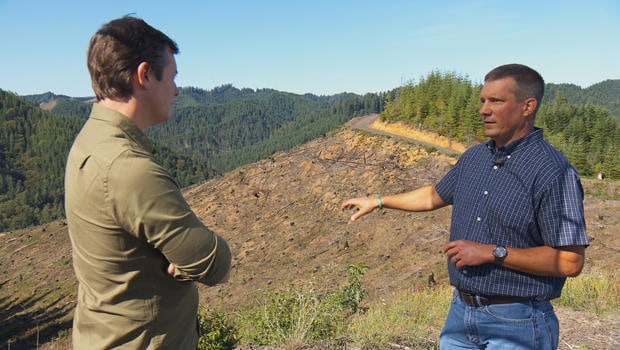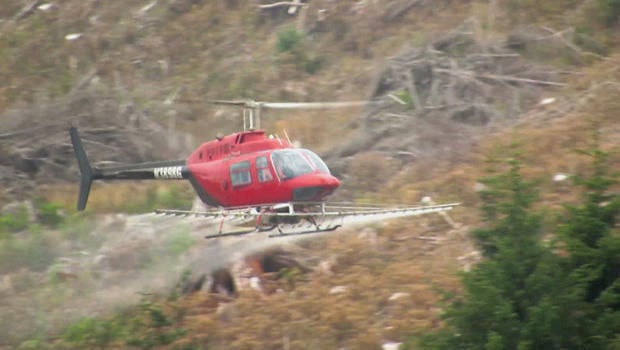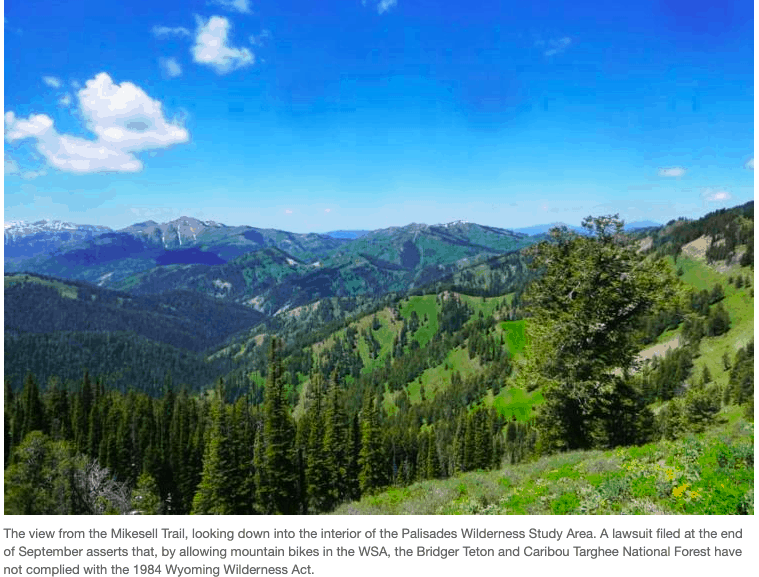Folks, I’m looking into USFS partnerships with states, counties, NGOs, etc. For now, I’m focusing on roads. For example, Gila County, Arizona, maintains ~500 miles of roads, mostly unpaved, on the Tonto NF. Are you aware of any other road-maintenance partnerships? Reply here or to me directly at [email protected]. — Steve Wilent
Uncategorized
Forest Carbon Perspectives
Our Matthew Koehler is a coauthor on an essay on the Missoula Current: “Logging drives carbon emissions from U.S. forests, escalates climate crisis,” by Danna Smith, Chad Hanson and Matthew Koehler, October 2, 2019:
“To effectively mitigate climate change, we must stop burning carbon for fuel and greatly increase forest protection. If we take ambitious steps to protect vastly more of our forests from industrial logging, we can avoid emissions while also actively absorbing large amounts of carbon from the atmosphere and storing it back on land in the forest where it belongs.”
This is a carbon-central viewpoint that we’ve debated here over the years.
A new publication from two professors, Paul Catanzaro, University of Massachusetts Amherst, and Anthony D’Amato, University of Vermont, offers a balanced perspective: “Forest Carbon: An essential natural solution to climate change.”
“To understand the full role of forests in the global carbon cycle, it is critical to consider both the amount of carbon stored in forest products and the amount of carbon that is saved when wood is used in place of more carbon-intensive materials, such as steel and concrete (i.e., substitution).”
Hunting nonprofit sues USFS for allowing mountain bikes and ATVs in Wilderness Study Area
Here’s a link to the full article from the Teton Valley News. Below are the first few paragraphs from the piece.
On Sept. 26, Mountain Pursuit, a hunters’ advocacy group in Jackson, filed a lawsuit against the Bridger Teton and Caribou Targhee National Forest for allowing mountain bike use in the Palisades Wilderness Study Area and ATV use in the Shoal Creek Wilderness Study Area.
In August of 2018, after the failure of the Teton County Wyoming Public Lands Initiative to make a recommendation to the Teton County Board of Commissioners on how to manage the local Wilderness Study Areas, Rob Shaul founded Mountain Pursuit to lobby for ethical hunting, wildlife and habitat conservation, and hunter education.
Shaul represented the general public in the WPLI committee, which formed in 2016 to address the question of management of the WSAs in Teton County. While a few different proposals, including one “middle ground” proposal spearheaded by Shaul, came before the committee, none of the plans received a majority vote and the committee ended its work without finding consensus.
“Through my two-plus years of working for compromise on the WPLI it was impressed upon me that in northwest Wyoming, Industrial Recreation is the primary threat to wildlife, and that those pushing recreation, including the mountain bike and motorized recreation advocates and businesses, were unwilling to compromise to protect wildlife,” Shaul wrote in an email to the Teton Valley News.
USFS and Scenario Investment Planning
Here’s an item that caught my eye in Mike Archer’s Wildfire News of the Day email today:
Wildfire NOTD subscriber Katie Lighthall, Coordinator for the Western Regional Strategy Committee (http://wildfireinthewest.blogspot.com), sent along their latest newsletter.
Demonstrations of Cohesive Wildland Fire Strategy in the West – Newsletter #66 https://mailchi.mp/5abe3d9605b5/news-cohesive-strategy-west-2418125?e=05ef71fab4
From the Cohesive Wildland Fire Strategy newsletter:
Oregon is the latest state to enter into a Shared Stewardship agreement with the US Forest Service to collectively set priorities and increase the scope and scale of critical forest treatments that support communities and improve forest conditions. In addition to the Oregon agreement signed this week, in recent months Idaho, Montana, Washington and Utah have signed on to these historical agreements that allow for mutual prioritization and implementation of landscape-scale projects for forest and watershed health, timber values and catastrophic wildfire prevention without the conflict of boundary lines. The agreements also allow for the use of new tools and technology such as the Scenario Investment Planning tool that helps land managers assess where investments will have the best outcomes based on specific priorities and achievement rates.
The Scenario Investment Planning Project (SIPP) web site says:
The scenario planning project is a US Forest Service initiative to improve investment strategies in landscape treatments. The tool will help explore tradeoffs and assess progress towards nationally identified priorities and targets. The tool fills a gap in current planning by providing a way to understand how priorities such as reducing wildfire impacts to communities at the national scale lead to outcomes on the ground. This project is integrating existing Forest Service models and data into a simulation framework to explore system-wide management scenarios and associated tradeoffs. The system will provide a method to analyze tradeoffs among land treatment investment strategies aimed at improving forest conditions and reducing wildfire risk. In contrast to typical assessments of forest conditions, this framework provides a way to optimize treatments at the stand scale to meet larger scale objectives and constraints (Watersheds, Forests, Regions), providing a linkage between national policy and on-the-ground implementation. This interdisciplinary project brings together scientists from landscape planning, fire ecology, operations research, and economics, to build linkages between science and operations that heretofore have not existed.
The SIPP website has lots of background info and a story map.
Forest Service proposes changes to Vegetation and Communication Sites Management Rules
FYI….
Media contact:
[email protected]
202-205-1134
www.fs.fed.us
News Release
USDA Forest Service proposes changes to address land management challenges
WASHINGTON – September 23 This week, the U.S. Department of Agriculture’s Forest Service will publish proposed changes to two regulations to implement new authorities the Forest Service received through the Agriculture Improvement Act of 2018—also known as the 2018 Farm Bill—and the 2018 Consolidated Appropriations Act. The legislation gives the USDA Forest Service direction and new tools to improve forest conditions, services, and safety on and around national forests and grasslands. The Forest Service is proposing several regulatory changes to use these new tools and authorities. The proposed regulations will be open for public comment for 60 days following their publication in the Federal Register.
“These new authorities help us face land management challenges by accelerating and broadening management efforts to work across boundaries” said Chief Vicki Christiansen. “These regulatory reforms represent a small part of the wealth of tools and authorities granted to us by the 2018 Farm Bill and the 2018 Consolidated Appropriations Act but will undoubtedly help us in our mission to improve the value and benefits of national forests.”
The proposed changes to the two rules are as follows:
The proposed rule regarding Vegetation Management in Utility Corridors would establish options and incentives for more effective and collaborative vegetation management between the Forest Service and utilities. These utilities operate more than 3,000 transmission lines in and around national forests and grasslands. Management focus would be to remove dead and dying trees that threaten these transmission lines and power structures. Removing these hazards would reduce fire risk as well as increase the reliability of energy delivered to more than 70 million American homes.
The proposed rule regarding Communication Sites Management aims to expedite application processes for individuals and companies that want to build communication sites on national forests and grasslands. These changes would help connect rural communities as well as improve customer service to those applying for and operating under special use permits for communication sites.
Communication sites on national forests and grasslands supports more than 10,000 wireless uses. These sites support critical communications, including emergency services, railroads, utility companies, and companies that provide personal communications services as well as television and radio broadcasts.
The proposed rules can be found on the Forest Service website and in the Federal Register at https://federalregister.gov/d/2019-20741 for Vegetation Management in Utility Corridors and https://federalregister.gov/d/2019-20742 fr Communication Sites Management.
###
CBS News asks “Who should be in charge of America’s ancient forests: industry or environmentalists?”

In the CBS News series “Eye on Earth,” “CBS This Morning: Saturday” co-host Jeff Glor looked at the debate over what to do with America’s ancient forests. You can watch the entire segment here.
I thought the following part of the news feature was particularly interesting, especially in the context of many discussions on this blog.
When asked why clear-cutting, Payne said, “We’re mimicking what Mother Nature’s done for billions of years.”
“But this looks traumatic for a lot of people when they see something like this,” Glor said.
“I actually look at it quite different,” said Payne. “I think it’s somewhat aesthetically pleasing.”
“You think that looks aesthetically pleasing?”
“I do. Maybe I’m somewhat biased, but when I look out, I see sustainability and rejuvenation,” he said.
“Not every company like yours is willing to talk about their story or take us to places like this. Why do you do it?”
“I think we as an industry have not done a very good job historically of telling our story,” Payne replied.
Timber companies have also traditionally used a practice called aerial spraying, in which chemicals are dropped by helicopter to kill any vegetation other than trees used for lumber.
Glor said, “A lot of people are concerned about spraying.”
“Well, I think people are just not informed well on that subject,” Payne replied. “We use it once or twice in a 50-year cycle.”
“It ultimately flows somewhere, though?”
“No, it doesn’t. No, a lot of times this stuff doesn’t flow off the landscape. The product will adhere to the vegetation that it’s targeted for, and stay there.”
Nancy Webster, who lives up the coast in Rockaway Beach, Oregon, is worried those chemicals seep into her drinking water: “This affects the fish, the wildlife, and we are up against large corporations. To even counter it, we need science and legal help, and it’s really difficult for small communities.”
Today, the situation may be reaching a critical point, because the federal government wants to suspend a public review process, which logging companies say needlessly ties them up in court.
Glor asked Payne, “Should there be a public review process when logging takes place on public lands?”
“Well, we have professionals in place in our federal agencies that are managing these lands, and I think we need to let them do that work,” Payne said.
In other words, he wants groups like Oregon Wild to stay away.

Court Enjoins Logging Using “Condition-Based Analysis”
A federal district court judge has preliminary enjoined the Tongass’ largest timber sale because the Forest Service relied on “condition-based analysis” in its EIS. In addition to stopping logging, the court’s decision puts a wrench in the Forest Service’s proposal to add condition-based analysis to its NEPA rules.
Condition-based analysis treats acres as fungible; location doesn’t matter. From the Forest Service and timber industry’s perspective, a board foot may be a board foot, but for wildlife, recreation, scenery, and most everything else, location does matter: “the Project EIS does not identify individual harvest units; by only identifying broad areas within which harvest may occur, it does not fully explain to the public how or where actual timber activities will affect localized habitats.”
The decision stops logging until the court issues its final merits ruling, which is promised by March 31, 2020.
Wilderness Watch: Wilderness represents a commitment to humility
Back in May, we discussed and debated the issue of chainsaws in designated Wilderness following the U.S. Forest Service’s decision to secretively approve “a policy to violate the Wilderness Act by allowing chainsaws to clear obstructed trails in the Weminuche and South San Juan Wildernesses” in Colorado. That USFS decision was followed by a lawsuit from the San Juan Citizens Alliance, Wilderness Watch and Great Old Broads for Wilderness, and shortly after the lawsuit was filed the USFS rescinded their approval of chainsaws in Wilderness.
Over the weekend, Wilderness Watch’s George Nickas penned the following oped in the Durango Herald.
Wilderness represents a commitment to humility
By George Nickas, Wilderness WatchBill Worf, the Forest Service’s first wilderness program leader and Wilderness Watch’s founder, liked to tell the story of when, shortly after the Wilderness Act passed in 1964, engineers at the Forest Service Development and Technology Center expressed interest in developing a “silent” chainsaw.
Their rationale was that if the newly passed wilderness bill prohibited noisy machines, a really well muffled chainsaw would pass muster since only the operator would hear it.
Bill told them not to bother – the Wilderness Act didn’t ban motorized equipment simply because it made noise, but rather because it represented a level of technology that was not in keeping with the ideals of the Wilderness Act.
Bill would have known. He served on the Forest Service task force that wrote the regulations and policies for implementing the Wilderness Act. Prior to that, as forest supervisor overseeing the Bridger Wilderness in northwest Wyoming, he had the opportunity to lead wilderness bill author and chief lobbyist Howard Zahniser on a trip into the Bridger.
Bill credited his time with Zahniser with helping him to understand that wilderness isn’t merely an undeveloped recreation area, but a place we accept on its own terms – a commitment to humility and restraint. This means using only the lightest touch when allowing for the public uses (recreation, science, education, etc.) wilderness provides.
Congress prohibited chainsaws because motorized tools are the antithesis of restraint – they allow humans to transform the landscape quickly and easily to meet our ends rather than transforming our own attitudes and desires to accommodate the landscape.
Chainsaws embody the attitude that our convenience, impatience and demands come first, that no place is beyond the reach of our attempts to dominate and control.
Authorizing chainsaws to clear trails, as the Forest Service regional forester for Colorado and Wyoming recently did, for the South San Juan and Weminuche wildernesses, strikes a blow to this foundational tenet of the Wilderness Act.
That’s why Wilderness Watch and our allies challenged his decision in court.
But there’s another reason the decision to allow chainsaw use should concern all who care about Wilderness.
The regional forester’s rationale – not enough trail crews to clear trails the traditional way – was essentially an admission that the Forest Service has failed to maintain an adequately staffed wilderness program. At a moment’s notice, the agency routinely assembles hundreds of firefighters, planes and heavy equipment to attack even a small wildfire, but from its nearly 30,000-plus employees and $5 billion budget, it can’t pull together a handful of trained trail crews to help clear the trails in the Weminuche and South San Juan wildernesses.
Why is that?
About two decades ago, the Forest Service effectively abandoned its wilderness program and outsourced the job to volunteers.
It began by diverting wilderness funds to pay the salaries of desk-bound bureaucrats, putting “wilderness” in their job descriptions to make the transfer seem legit. But the main effort was on creating “partnerships” with volunteer groups to mask that the wilderness program was being gutted.
So today, while many wildernesses have volunteer “friends” groups trying to keep trails open or plug holes elsewhere, the agency’s program of a professionally trained and skilled field-going wilderness force has – to borrow a phrase from Bob Marshall – faded like a south-facing snowbank under a June sun.
The real lesson from the proposed chainsaw assault on the wilderness isn’t that the Forest Service is ignoring the Wilderness Act – that’s hardly news at all.
The most important takeaway is that Forest Service leadership has so decimated the agency’s wilderness program that using chainsaws to clear trails is even being discussed.
George Nickas is the executive director of Wilderness Watch, a national conservation organization dedicated to protecting the lands and waters in the National Wilderness Preservation System, headquartered in Missoula, Montana.
Chaining of pinyon-juniper in Grand Staircase-Escalante National Monument
Chaining of pinyon-juniper forests is back in the news. Today’s Greenwire:
Appeals board upends Trump admin plans to raze Utah forest
Heather Richards, E&E News reporter
Published: Tuesday, September 17, 2019
Environmental groups have upended the Interior Department’s plans to cut down most of a scraggly forest covering about 30,000 acres of southern Utah within the Grand Staircase-Escalante National Monument.
The Interior Board of Land Appeals ruled yesterday that the Bureau of Land Management failed to consider how cutting down pinyon and Utah juniper trees would affect migratory birds. The appeals board also found BLM’s plan to use “non-native” seed — a part of its habitat improvement plans — was a mistake, as it conflicted with the agency’s management guidelines.
The board bucked other complaints in the appeal, such as conservationists’ argument that BLM failed to properly account for a climate change impact from bringing down the forest. That argument has been fairly effective for environmental groups in recent months for protests and lawsuits of oil and gas development on public land.
National Geographic a couple of weeks ago (with a misleading photo of a lone pinyon pine growing from a rock like a bonzai tree):
Forests on Utah’s public lands may soon be torn out. Here’s why.
The U.S. is moving forward with a plan to create new cattle pasture and prevent fires despite what scientists say is meager environmental review.
Machine tracks in the sand frame the site near Grand Staircase-Escalante National Monument, a harbinger of its vanishing solitude. The federal government plans to remove an unprecedented number of trees here, it says to reduce fire risk, improve habitat for greater sage grouse, and increase forage for cattle and a world-renowned trophy-hunting deer herd.
And it plans to do it fast. The Bureau of Land Management failed to conduct a thorough environmental analysis of the project that considered the impacts of cutting trees on the climate, said scientists who appealed to a federal review board to stop it. If approved, the effort could define how the nation’s most sensitive public lands are managed for a generation.
We’ve discussed this issue here, such as:
Judge Rules Agencies Failing to Ensure Recovery of Mexican Spotted Owl in Violation of Endangered Species Act
Here’s a press release from WildEarth Guardians about an issue that has been discussed on this blog before.
Santa Fe, NM – A Federal District Court Judge in Arizona ruled on September 11 that the U.S. Fish and Wildlife Service and the U.S. Forest Service have shirked their responsibilities to ensure that Forest Service management activities are making progress towards recovery of the Mexican spotted owl, a species protected under the Endangered Species Act. WildEarth Guardians filed the case in March 12, 2013 over the agencies’ failure to ensure the recovery of the owl by collecting basic information, for more than 20 years, about the status of owl populations across the Southwest.
The ruling halts all “timber management actions” on six national forests in New Mexico and Arizona including all the national forests in New Mexico and the Tonto National Forest in Arizona. None of the 11 national forests in the two-state Southwestern Region have adequately monitored owl populations. The lawsuit originally targeted all 11 national forests in New Mexico and Arizona. However the five national forests in Arizona not subject to the injunction on logging completed new forest plans with new Endangered Species Act (ESA) consultations since the original filing of this lawsuit which led the judge to find that the lawsuit was moot on those forests.
“This decision is about agency accountability, to the public and to the recovery of the Mexican Spotted Owl,” explained John Horning, Executive Director of WildEarth Guardians. “With this decision, the agencies will finally be held accountable for ensuring that all forest management practices help, not hinder, owl recovery.”
As the decision explains, the Forest Service was required to implement a population monitoring protocol for Mexican Spotted Owl since at least 1996. It was expected that, within 10-15 years, management activities such as logging and prescribed burning that the agencies claimed would improve owl habitat, supported by monitoring that would show the species recovery, would enable its de-listing from the Endangered Species Act. Yet, as the decision states, “Over twenty years later, delisting has not occurred, and information about the current [Mexican spotted owl] population is still minimal.”
“The judge’s recent decision constitutes the clearest possible rebuke to this foot-dragging, and recognizes that the Forest Service’s failure to monitor Mexican spotted owl populations has enabled the agency to avoid accountability for its failed conservation efforts,” stated Horning. “Thankfully for these national forests and for the Mexican spotted owl, those days have now finally come to an end.”
The decision requires the agencies to initiate consultation pursuant to the ESA “addressing occupation monitoring of the MSO for recovery.” Because timber harvesting and other related activities may cause irreparable harm to the owl, the court has enjoined timber management actions, including timber harvesting, until consultation is complete. This is necessary, the Court recognized, because “It has been demonstrated over the past 20 years that the status quo will not lead to recovery of the listed species.”
“While the Forest Service finally steps up to its conservation obligations and assesses how its management programs affect the recovery of the Mexican spotted owl as a species, certain timber projects will be paused in light of the judge’s decision,” explained Steve Sugarman, the attorney representing WildEarth Guardians. “WildEarth Guardians has already opened up a dialogue with the Forest Service to assure that this pause will be orderly, and that it will not unnecessarily impede the implementation of projects that are truly necessary for the protection of life and property.”


